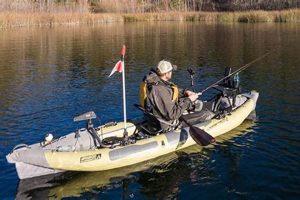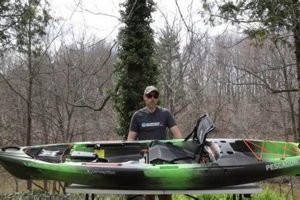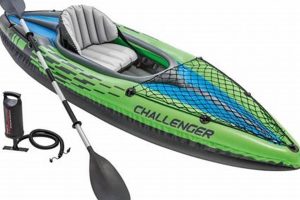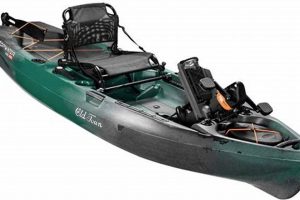A high-quality personal flotation device (PFD) designed specifically for kayak angling offers numerous specialized features. These may include pockets and attachment points for fishing gear, high-visibility colors for safety, and comfortable designs that allow for a full range of motion while paddling and casting. An example would be a PFD with integrated pliers holders, rod leash attachments, and a large back pocket for storing a tackle box.
Choosing an appropriate PFD is critical for angler safety and enhances the fishing experience. A well-designed fishing PFD provides buoyancy in case of capsizing, offers storage solutions for essential equipment, and contributes to overall comfort during long hours on the water. Historically, PFDs evolved from bulky cork life jackets to the lightweight, specialized designs available today, reflecting advancements in materials and a growing understanding of the unique needs of various water sports, including kayak fishing.
The following sections will explore key factors to consider when selecting a PFD for kayak fishing, including different types of designs, essential features, and proper fitting techniques. Further discussion will cover recommended maintenance and care practices to ensure the long-term effectiveness and safety of these vital pieces of equipment.
Tips for Selecting a Premium Kayak Fishing PFD
Choosing a suitable personal flotation device (PFD) significantly impacts safety and comfort while kayak fishing. Careful consideration of various factors ensures optimal performance and a secure experience on the water.
Tip 1: Prioritize Fit and Comfort: A properly fitted PFD allows unrestricted movement for paddling and casting. Ensure a snug fit without hindering mobility. Consider adjustable straps and varying sizes to accommodate different body types.
Tip 2: Evaluate Storage Capacity: Ample storage is crucial for carrying essential fishing gear. Look for PFDs with multiple pockets and attachment points designed to hold tools, tackle boxes, and accessories securely.
Tip 3: Consider High-Visibility Colors: Enhanced visibility increases safety, especially in low-light conditions or crowded waterways. Opt for bright colors and reflective elements to improve visibility to other boaters.
Tip 4: Assess Material Durability and Construction: Select a PFD constructed from durable, water-resistant materials that can withstand the rigors of kayak fishing. Reinforced stitching and corrosion-resistant hardware are essential for longevity.
Tip 5: Check for Fishing-Specific Features: Specialized features like integrated pliers holders, knife sheaths, and rod leash attachments enhance convenience and efficiency while fishing.
Tip 6: Ensure Proper Buoyancy and Safety Certification: Select a PFD that meets or exceeds safety standards and provides adequate buoyancy for your weight and intended fishing environment. Verify appropriate certification labels.
Tip 7: Try Before You Buy: Whenever possible, try on different PFDs before purchasing to ensure a comfortable fit and evaluate features. Mimic paddling and casting motions to assess range of motion.
By carefully considering these factors, anglers can choose a PFD that maximizes both safety and performance on the water, allowing for a more focused and enjoyable fishing experience.
These tips provide a foundational understanding of important PFD selection criteria. The following section will delve into specific product recommendations and reviews to assist in making an informed purchase decision.
1. Safety
Safety represents a paramount concern in kayak fishing, and the choice of personal flotation device (PFD) plays a critical role. A properly fitted and inherently buoyant PFD is essential for survival in the event of capsizing or unexpected immersion. This is especially crucial in challenging conditions such as cold water, strong currents, or open water environments. A secure PFD allows anglers to focus on fishing with reduced risk, contributing to a more confident and enjoyable experience. For example, an angler who experiences an unexpected wave while fishing offshore gains critical seconds for self-recovery with a reliable PFD, potentially preventing a life-threatening situation.
Beyond basic flotation, enhanced safety features elevate the protective capacity of a kayak fishing PFD. High-visibility colors increase the wearer’s visibility to other boaters, reducing the risk of collisions, particularly in low-light or foggy conditions. Reflective elements further enhance visibility during nighttime excursions. Integrated whistles provide a crucial signaling tool for attracting attention in emergencies. Secure attachment points for essential gear like knives and lights ensure these items remain accessible in critical situations. The strategic combination of these features significantly mitigates risks associated with kayak fishing.
Understanding the critical link between PFD selection and angler safety is fundamental to a responsible approach to kayak fishing. While features like storage and comfort enhance the overall experience, the prioritization of safety features remains paramount. Choosing a PFD that adheres to safety standards, fits correctly, and incorporates appropriate safety features is an investment in personal well-being and contributes significantly to a safer and more enjoyable fishing experience. Regular inspection and maintenance of the PFD further ensure its continued effectiveness in providing crucial protection on the water.
2. Comfort
Comfort is a critical factor influencing performance and enjoyment during extended kayak fishing trips. A poorly fitting or uncomfortable personal flotation device (PFD) can restrict movement, cause chafing, and contribute to fatigue, detracting from the overall fishing experience. Conversely, a comfortable PFD allows anglers to focus on fishing, maximizing enjoyment and potentially improving results.
- Adjustability
Adjustable straps at the shoulders, sides, and waist allow for a customized fit, accommodating different body types and layering preferences. This adjustability ensures a snug, secure fit without restricting movement during paddling and casting. For example, an angler wearing multiple layers during colder weather can adjust the straps to accommodate the extra bulk without compromising comfort or safety. A well-adjusted PFD moves with the body, preventing chafing and discomfort during long hours on the water.
- Breathability
Breathable materials and ventilation panels promote airflow, preventing overheating and moisture buildup, especially in warm or humid conditions. Mesh panels strategically placed on the back and sides allow heat and perspiration to escape, maintaining comfort and reducing the risk of skin irritation. An angler fishing in tropical climates benefits significantly from a breathable PFD, preventing discomfort and allowing for extended periods of activity.
- Padding and Weight Distribution
Strategic padding and weight distribution enhance comfort and reduce pressure points. High-density foam padding strategically placed at key contact points provides cushioning and support, minimizing discomfort during prolonged wear. Evenly distributed weight prevents strain on specific areas like the shoulders and neck. An angler carrying heavier gear appreciates the load-bearing capacity and weight distribution of a well-designed PFD, reducing fatigue and enhancing overall comfort.
- Design and Mobility
A well-designed PFD allows for a full range of motion required for paddling, casting, and reeling. Articulated designs and flexible panels ensure unrestricted movement, allowing anglers to perform fishing-related activities without hindrance. A low-profile design minimizes interference with paddling strokes, while strategically placed pockets and attachment points maintain easy access to gear without impeding movement. This mobility is essential for effective fishing and contributes to a more enjoyable and less strenuous experience.
Prioritizing comfort in PFD selection contributes significantly to a positive kayak fishing experience. A comfortable PFD allows for extended periods on the water without distraction or discomfort, enabling anglers to fully focus on the task at hand and enhancing overall enjoyment and performance. Selecting a PFD that balances comfort with essential safety features results in a well-rounded and effective piece of equipment.
3. Storage
Ample and well-organized storage is a defining characteristic of a high-quality fishing kayak vest. Efficient storage solutions allow anglers to keep essential tools and tackle readily accessible, maximizing fishing efficiency and minimizing disruptions. The strategic placement and design of pockets and attachment points contribute significantly to a streamlined and productive fishing experience.
- Pocket Variety and Placement
Multiple pockets of varying sizes accommodate a range of items, from small tools and flies to larger accessories like fishing licenses and sunscreen. Strategically placed pockets, such as chest pockets for frequently used items and larger back pockets for less accessed gear, optimize organization and accessibility. An angler needing quick access to a fly box benefits from readily accessible chest pockets, while a larger back pocket securely holds rain gear until needed.
- Secure Closure Mechanisms
Reliable closure mechanisms, such as zippers, Velcro, and magnetic closures, prevent items from falling out during movement or capsizing. Secure closures ensure valuable gear remains protected and readily available, minimizing the risk of loss and maximizing peace of mind. An angler navigating rough waters can be confident that essential tools remain secured within the vest, preventing loss and potential safety hazards.
- Specialized Attachment Points
Dedicated attachment points for tools like pliers, nippers, and line cutters offer convenient access and secure storage. Retractors or sheaths keep tools readily available while preventing loss or entanglement. An angler needing to quickly cut a fishing line benefits from a readily accessible knife or line cutter secured to the vest, enhancing efficiency and safety.
- Water Resistance and Drainage
Water-resistant materials and drainage grommets protect stored items from moisture and facilitate quick drying. These features prevent gear damage and maintain the vest’s overall functionality in wet conditions. An angler fishing in rainy conditions or experiencing splashes benefits from water-resistant pockets, keeping essential items dry and functional.
Effective storage solutions directly impact the efficiency and enjoyment of kayak fishing. A well-designed vest with ample, secure, and specialized storage allows anglers to maintain organization, focus on fishing, and respond quickly to changing conditions or fishing opportunities. The thoughtful integration of these storage features elevates a standard PFD to a specialized and highly effective tool for the serious kayak angler.
4. Durability
Durability is a critical factor determining the lifespan and overall value of a fishing kayak vest. Exposure to harsh elements, including sun, water, and abrasion from fishing gear, necessitates a robust construction capable of withstanding these challenges. A durable vest represents a long-term investment, providing reliable performance and safety over extended use. For example, a vest constructed from abrasion-resistant fabric maintains its structural integrity despite frequent contact with fishing hooks and other sharp objects. Reinforced stitching at stress points further enhances durability, preventing premature wear and tear in high-use areas like strap attachments and pocket seams.
The selection of durable materials contributes significantly to a vest’s resistance to wear and tear. High-tenacity fabrics like ripstop nylon or polyester provide excellent tear strength and abrasion resistance. Corrosion-resistant hardware, such as stainless steel buckles and zippers, ensures continued functionality in saltwater environments. High-quality construction techniques, including reinforced stitching and bonding, enhance the vest’s overall structural integrity. These material and construction choices contribute to a vest’s ability to withstand the rigors of frequent use and exposure to challenging conditions. A vest constructed with these durable components remains functional and safe over numerous fishing trips, justifying the initial investment.
Understanding the importance of durability in a fishing kayak vest enables informed purchasing decisions, leading to a more reliable and cost-effective investment. Evaluating materials, construction techniques, and manufacturer reputations allows anglers to select vests built to withstand the demands of their fishing environment. Choosing a durable vest minimizes the need for frequent replacements, contributing to long-term cost savings and consistent performance on the water. Ultimately, a durable vest enhances safety and provides peace of mind, knowing the equipment will perform reliably in demanding situations.
5. Fishing-Specific Features
The distinction between a standard personal flotation device (PFD) and a premium fishing kayak vest lies primarily in the incorporation of fishing-specific features. These specialized design elements significantly enhance angler efficiency, safety, and overall fishing experience. These features cater directly to the needs of anglers, transforming a basic safety device into a highly functional piece of fishing equipment. The presence and quality of these features directly influence a vest’s classification as “best,” signifying superior performance and utility.
Examples of such features include integrated rod holders, which secure rods while paddling or changing lures, freeing hands for other tasks. Retractable tool lanyards keep essential tools like pliers and nippers readily accessible while preventing loss. Dedicated attachment points for fishing accessories, such as fly patches or knife sheaths, further streamline workflow. An angler battling a strong fish benefits from a secure rod holder, preventing rod loss and allowing for better control. Similarly, quick access to pliers via a retractable lanyard facilitates efficient hook removal, minimizing stress on the fish and expediting release.
The practical significance of these features lies in their contribution to a more streamlined and productive fishing experience. By keeping essential tools and equipment readily accessible and organized, anglers can focus on fishing, minimizing distractions and maximizing time on the water. The integration of fishing-specific features elevates a kayak fishing PFD from a basic safety device to a purpose-built tool designed to optimize performance. The inclusion of these specialized features distinguishes the best fishing kayak vests from standard PFDs, representing a key consideration for discerning anglers seeking to enhance their fishing experience.
Frequently Asked Questions
This section addresses common inquiries regarding the selection, use, and maintenance of fishing kayak vests. Understanding these key aspects ensures informed purchasing decisions and promotes safe and effective use on the water.
Question 1: What differentiates a fishing kayak vest from a standard life vest?
Fishing kayak vests incorporate specialized features like pockets for tackle, attachment points for tools, and rod holders, enhancing angler convenience and efficiency. Standard life vests prioritize basic flotation without these specialized features.
Question 2: How important is proper fit when choosing a fishing kayak vest?
Proper fit is crucial for both safety and comfort. A poorly fitting vest can restrict movement and reduce effectiveness in the event of a capsize. Conversely, a correctly fitted vest allows for a full range of motion while providing optimal buoyancy and support.
Question 3: What are the key safety features to consider in a fishing kayak vest?
Essential safety features include inherent buoyancy, high-visibility colors, reflective elements, and a secure, reliable closure mechanism. An integrated whistle and attachment points for safety lights further enhance visibility and emergency preparedness.
Question 4: How should a fishing kayak vest be maintained to ensure long-term performance?
Regular rinsing with fresh water after each use removes salt and debris, prolonging the vest’s lifespan. Proper storage in a cool, dry place prevents mildew and material degradation. Periodic inspection of straps, buckles, and zippers ensures continued functionality and safety.
Question 5: What are the different types of fishing kayak vest designs available, and how do they differ?
Fishing kayak vests generally fall into two categories: inflatable and inherently buoyant. Inflatable vests offer a more compact profile when deflated but require manual or automatic inflation. Inherently buoyant vests provide continuous flotation using foam panels, offering immediate buoyancy without any activation steps.
Question 6: Are there any specific regulations regarding the use of fishing kayak vests?
Regulations regarding PFD use vary by jurisdiction and often depend on factors like water conditions and vessel type. It is essential to consult local boating regulations to ensure compliance with specific requirements and prioritize safety on the water.
Careful consideration of these frequently asked questions provides a comprehensive understanding of the essential aspects of fishing kayak vest selection, use, and maintenance. Prioritizing safety, comfort, and functionality ensures a positive and productive fishing experience.
For further information and specific product recommendations, consult the detailed product review section below.
Conclusion
Selecting a premium kayak fishing personal flotation device (PFD) requires careful consideration of various factors, including safety features, comfort, storage capacity, durability, and specialized fishing-specific design elements. Prioritizing these key aspects ensures optimal performance, enhances safety, and contributes to a more productive and enjoyable fishing experience. Understanding the critical role of a well-chosen PFD in angler safety and overall performance underscores the importance of informed decision-making.
Investing in a high-quality kayak fishing PFD represents an investment in personal safety and long-term fishing enjoyment. Careful evaluation of available options, combined with a clear understanding of individual needs and fishing conditions, empowers anglers to make informed choices that enhance both safety and performance on the water. The selection of appropriate safety equipment contributes significantly to a responsible and fulfilling angling experience.






